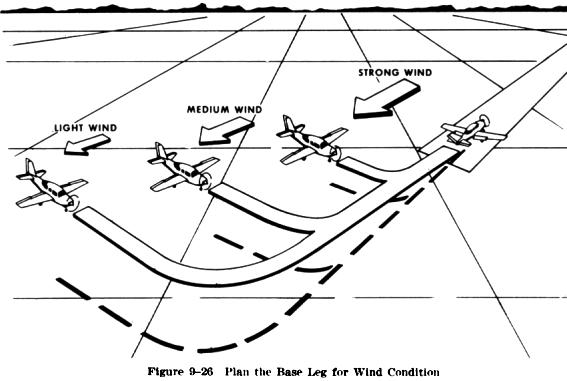
This approach is made from a base leg and requires only a 90 degree turn onto the final approach. The approach path may be varied by positioning the base leg closer to or father out from the approach end of the runway according to wind conditions (Fig. 9-26)

The glide from the key position on the base leg through the 90 degree turn to the final approach is the final part of all accuracy landing maneuvers.
The 90 degree power off approach is usually begun from a rectangular pattern at approximately 800 feet above the ground or at normal traffic pattern altitude. The airplane should be flown onto a downwind leg at the same distance from the landing surface as in a normal traffic pattern. The prelanding procedure should be completed on the downwind leg, including extension of the landing gear if the airplane is equipped with retractable gear.
After a medium banked turn onto the base leg is completed, the throttle should be retarded slightly and the airspeed allowed to decrease to the normal base leg speed (Fig. 9-27). On the base leg, the airspeed, wind drift correction, and altitude should be maintained while proceeding to the "45 degree key position". At this position the intended landing spot will appear to be on a 45 degree angle form the airplanes's nose.

The pilot can determine the strength and direction of the
wind from the amount of crab necessary to hold the desired ground track
on the base leg. This will help in planning the turn onto the final approach
and in lowering the correct amount of flaps.
At the 45 degree key position, the throttle should be
closed completely, the propeller control (if so equipped) advanced to the
full increase RPM position, and altitude maintained until the airspeed
decreases to the manufacturer's recommended glide speed. In the absence
of a recommended speed, use 1.4 Vs0. When this airspeed is attained, the
nose should be lowered to maintain the gliding speed and the controls retrimmed.
The base to final turn should be planned and accomplished so that upon rolling out of the turn the airplane will be aligned with the runway centerline. When on final approach, the wing flaps are lowered and the pitch attitude adjusted as necessary to establish the proper descent angle and airspeed (1.3 Vs0), then the controls retrimmed. Slight adjustments in pitch attitude or flaps setting may be necessary to control the glide angle and airspeed. However, NEVER TRY TO STRETCH THE GLIDE NOR RETRACT THE FLAPS to reach the desired landing spot. The final approach may be made with or without the use of slips.
After the final approach glide has been established, full
attention must be given to making a good, safe landing rather than concentrating
on the selected landing spot. The probability of landing on the spot was
already determined by the base leg position and the flap setting. In any
event it is better to execute a good landing two hundred feet from the
spot than to make a poor landing precisely on the spot.